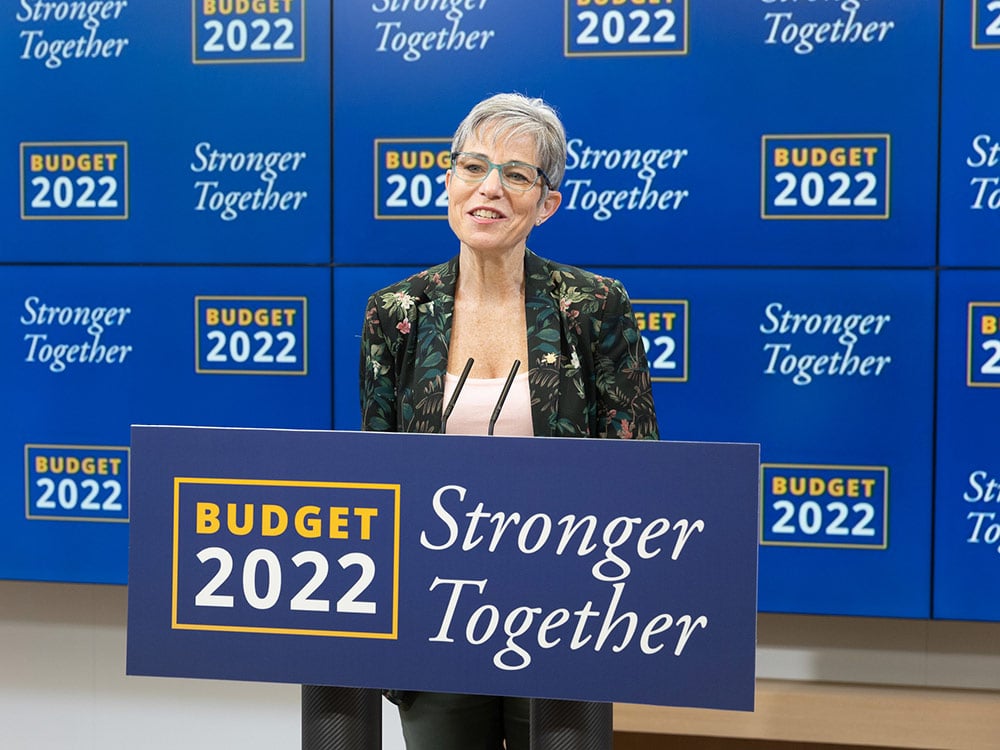With inflation running higher than it has for decades, the B.C. government has chosen to freeze income and disability assistance rates this year.
The NDP government has raised assistance rates three times since taking office in 2017. But despite annual inflation of more than four per cent, last week’s budget didn’t include an increase in the rates.
Asked about the decision to freeze the rates, Finance Minister Selina Robinson said the government had provided “the largest increase to disability rates in the history of this province” in 2021.
The government had temporarily increased rates by $300 a month earlier in the COVID-19 pandemic, then cancelled that and replaced it with a smaller permanent increase of $175 per month.
Total amounts of assistance vary depending on family size and which benefits people qualify for.
With last year’s raise, a single person receives $935 from income assistance or $1,358 on disability assistance. A couple with one child would receive $1,611 on income assistance, plus about $700 in federal and provincial child benefits.
The rates include a shelter allowance that starts at $375 a month for a single person. A family of seven would get $865 for shelter.
Robinson said the government is doing more than providing money to help people living in poverty. “We’ve also been building a lot of housing, which is also to support that population,” she said. “We’ve built in permanent supports.”
Marc Lee, a senior economist with the BC Office of the Canadian Centre for Policy Alternatives, said the government could do more to help people in need.
“They increased disability rates last year, but just with the inflation that we’ve had in the last year it probably erodes most of the increase, and if you’re on just regular income assistance you’re even further back,” he said.
“The government has now acknowledged the minimum wage should go up by rate of inflation,” said Lee, “so why shouldn’t welfare rates go up by the rate of inflation?”
The rates are already out of step with what it costs people to live, he added.
“Just that idea that $375 ought to be the shelter allowance as part of that, it’s just a complete joke to anyone.”
A summary comparing welfare incomes in provinces across Canada for 2020 from the Maytree Foundation showed B.C.’s rates were among the top three. The incomes were calculated using both the provincial and federal benefits available to four sample types of household.
In a December article for The Tyee, Paloma Pacheco quoted dm gillis on the stress of surviving on a B.C. disability payment.
“After my month’s rent and bills are paid, I have $14 a day to live on,” he said. “The week leading up to cheque issue day is usually one of one meal a day. It’s difficult to manage with diabetes. It’s something those who legislate poverty can’t and won’t try to understand.”
Matthew Ford in Victoria told Pacheco that it was easier to survive with the extra $300 earlier in the pandemic. “When they stopped, and the prices of food began climbing, I had to start looking around for food banks and other places that support the needy.”
On budget day the executive director of the Homelessness Services Association of BC, Stephen D’Souza, said income and disability assistance rates fall short of what’s needed for people to find housing.
“It already wasn’t livable,” he said, adding the rates should be tied to inflation.
Bill Hopwood, a long-time advocate for higher rates living in Vancouver’s Downtown Eastside, said Robinson and other cabinet ministers must be aware that $375 for shelter is too little.
“You can’t get a dog kennel for that,” Hopwood said, adding that even for housing providers who want to charge the government’s shelter rate it’s not enough to cover maintenance. “They need to raise the shelter rates to a realistic level.”
Assistance rates that are too low mean people turn to panhandling, binning for returnable cans and bottles and survival sex, he said. “It’s misery and it’s insecurity. And people die.” ![]()
Read more: Rights + Justice, BC Politics
















Tyee Commenting Guidelines
Comments that violate guidelines risk being deleted, and violations may result in a temporary or permanent user ban. Maintain the spirit of good conversation to stay in the discussion.
*Please note The Tyee is not a forum for spreading misinformation about COVID-19, denying its existence or minimizing its risk to public health.
Do:
Do not: